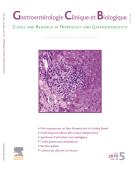Sentinel lymph nodes of colorectal carcinoma: reappraisal of 123 cases - 26/03/08
Gabriel LIBERALE [1],
Philippe LASSER [1],
Jean-Christophe SABOURIN [2 et 3],
David MALKA [4],
Pierre DUVILLARD [2],
Dominique ELIAS [1],
Valérie BOIGE [4],
Diane GOÉRÉ [1],
Michel DUCREUX [4],
Marc POCARD [1 et 5]
Mostrare le affiliazioniLe ganglion sentinelle dans les cancers colorectaux: étude de réévaluation sur 123 cas |
Objectifs |
L'intérêt du ganglion sentinelle (GS) est non établi pour les cancers colorectaux. Il pourrait: réorienter le curage en peropératoire (cartographie lymphatique), éviter une analyse de toute la pièce avec le seul GS (exactitude) et isoler des micrométastases permettant de modifier le stade histopronostique.
Méthodes |
La technique a été l'injection de bleu patenté. Les GS ont été analysés par coupes sériées en HES.
Résultats |
Un GS a été envisagé chez 123 malades, réalisé avec succès pour 112/118 cas (faisabilité 95 %). Le nombre médian de ganglions et de GS a été respectivement de 20 (5-74) et de 2 (1-5). i) la cartographie lymphatique peropératoire du GS a été utilisée pour adapter le geste chirurgical dans 11 % des cas. ii) pour 36 malades classés N+, dans 14 cas le GS était négatif (39 % de faux négatif). iii) 84 malades ont été classés N0 en première lecture, puis 8 ont été up-gradés N+ (10%), après découverte de micrométastases en HES dans le GS.
Conclusions |
L'analyse du GS ne peut remplacer l'analyse de tous les ganglions. Les coupes multiples en HES permettent de modifier le stade 10 % des N0 et modifie leur prise en charge.
Aims |
Results concerning the usefulness of the sentinel lymph node (SLN) in colorectal carcinoma have been discordant. The SLN technique may be used to guide surgical resection (lymph mapping), restrict the lymph node analysis solely to the SLN (accuracy) and upgrade tumor staging when micrometastases are specifically detected in the SLN.
Methods |
The blue dye injection technique was used. Serial sections of the SLNs were analyzed after hematoxylin-eosin (HES) staining.
Results |
The SLN technique was tested in 123 patients, successfully in 112/118 (feasibility 95%) (five intraoperative exclusions). On average, twenty lymph nodes (range: 5-74) and two SLNs (range: 1-5) were identified. Lymph mapping was used in 11% of patients to guide surgical resection; the SLN was negative in 14 of 36 N+ patients (39% false-negatives); HES staining enabled detection of micrometastases in 8 of 84 initially N0 patients (10% secondary upgrading to N+).
Conclusion |
Limiting node analysis to the SLN cannot replace a complete pathology examination of all resected lymph nodes. Careful examination of serial sections of the SLN can however affect therapeutic decision making since staging may be upgraded in up to 10% of initially N0 patients.
Mappa
© 2007 Elsevier Masson SAS. Tous droits réservés.
Vol 31 - N° 3
P. 281-285 - Marzo 2007 Ritorno al numeroBenvenuto su EM|consulte, il riferimento dei professionisti della salute.

